As we approach the beginning of February I like to finish sowing my sowing sweet peas for the summer. Sweet peas are the first of the annual flowers that I sow for my Cutting Garden every year. These beautiful frilly scented blooms are an early summer staple, producing plenty of cutting material from June to the end of July and often on into August and September if I have been rigorous about dead heading.
Sweet peas look beautiful on their supports, flower abundantly and have that unmistakable scent of summer when gathered together in a posy - a bunch of sweet peas on my kitchen windowsill is a summer must. My favourite colours are the delicate pastel pinks and lavenders, but I always grow a few dark varieties for contrast in the vase. Sadly 2015 was another poor year for my outdoor crop - for the second time my sweet peas were covered in tiny black pollen beetles making the flowers unusable inside. Apparently the beetles love the yellow flowers of the rapeseed crop and as these flowers fade they fly off in search of a new home - yet again my sweet pea crop proved very attractive to them. I did resolve last summer to concentrate my efforts on growing sweet peas under cover this year and forgo my outdoor crop, but gardening is often more about anticipation than results and I just cannot help but have another go outside this year. If nothing else these flowers add height and beauty to the Cutting Garden!
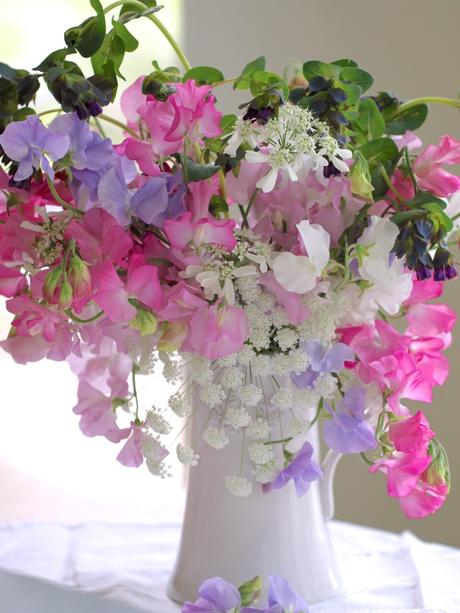
Although there is plenty of advice to the contrary I always soak my sweet pea seeds overnight before sowing - I find this speeds up germination considerably. I pour each variety of seed into a separate jam jar with the label underneath so that I do mot get the seeds mixed up. After soaking I drain each jar of seeds into a tea strainer and pour the plumped up seeds back into their packet.

After soaking overnight the seeds almost double in size and sometimes start to sprout right there in the jar.
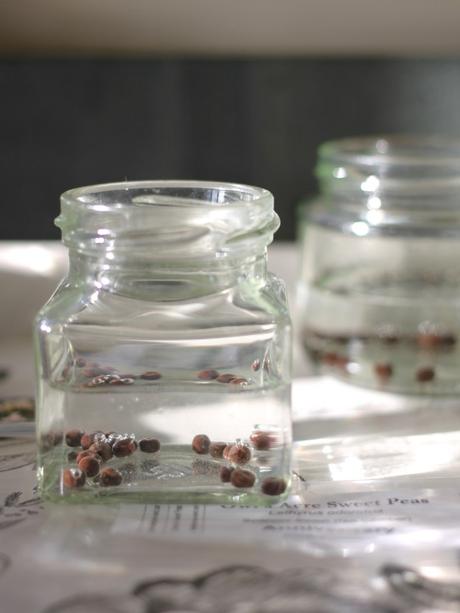
I then sow the seeds two to a plug into root trainers. Root trainers are ideal for sowing peas, beans and sweet peas, which all have long root growth.
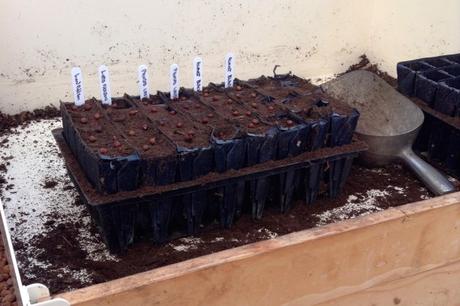
After sowing, the seeds are well watered and then placed in my heated propagator to germinate. They would germinate just as well without heat, but the propagator speeds things up. I have never covered them to exclude light whilst they germinate, although many guides do recommend to do this. Within 4-5 days the seedlings will be showing and I will move them onto the greenhouse staging for a couple of weeks. After that it is into the cold frames to carry on growing and harden off before planting out, hopefully in late March or early April. In previous years I have pricked out the growing tip of the young plants just above a set of leaves to thicken them and create more bushy growth.
This year I am going to try the cordon method of growing - I will not prick out the growing tip and, as with tomatoes, I will remove all the side shoots as the plants grow to encourage one straight strong stem. This is the growing method which is meant to produce the largest flowers and longest stems which are in turn the best for cutting. I am aiming for quality over quantity this year!
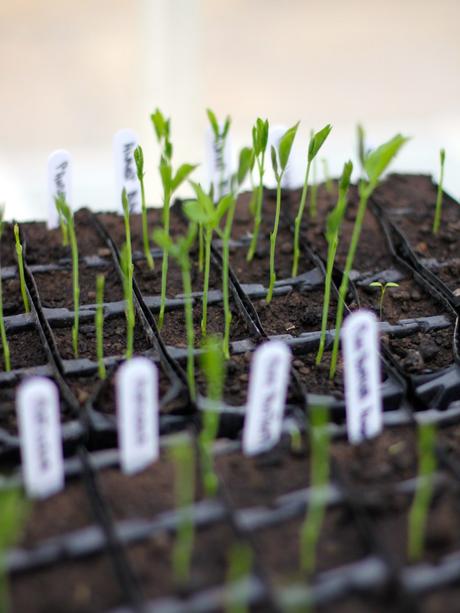
Sweet peas love a rich moist soil in a bright sunny position and they are hungry plants (you cannot expect huge growth and mountains of flowers without generous feeding). Whilst they are in their pots the compost will feed them for the first 6 weeks or so of growth. As they will remain in their pots for a few more weeks until conditions are suitable for planting out, after about 5 weeks I will start to add liquid seaweed to the watering can once a week.
During February (weather permitting) I will prepare their planting space. I have adopted a metal runner bean frame which I cover with jute netting to support my sweet peas - this has proved very successful. I order the jute netting from Agriframes - it is much nicer to use than pea netting, which drives me to distraction as it knots itself around everything except my supports. At the end of the year the jute netting can be composted along with the old plants, which saves the frustrating task of trying to store unruly plastic pea netting in a tidy way.
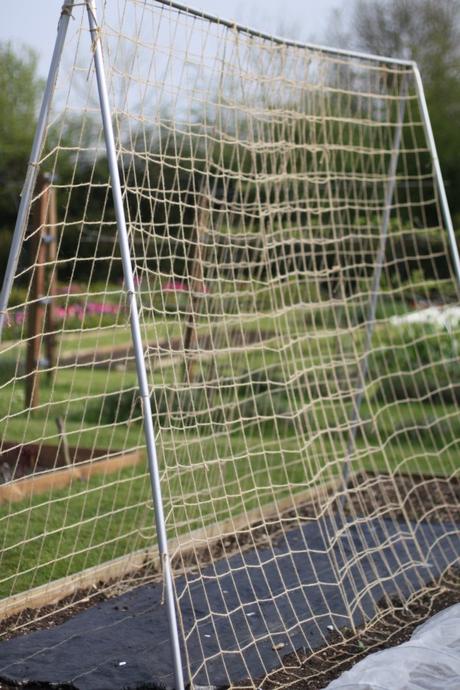
This year I am going to prepare the soil by digging plenty of well rotted farmyard manure in a few weeks before planting the young plants 6 inches apart. After the plants have been transferred to their growing site I will continue with regular watering and a weekly feed of tomato food or liquid seaweed. A few weeks after planting I will start tying in the young plants to the jute netting to keep them in an upright position so that the stems climb up the supports rather than trail on the ground or become intertwined with each other. If a hard frost is forecast I will throw a fleece over the young plants just in case, but really they are quite hardy and cope well with the cool spring weather. Once they start to flower I will continue feeding and watering, making sure that all the flowers are cut off the plants at least once a week to stop them running to seed. With this regime they should be flowering from mid June until well into September, although the longest stems will only last for the first 6 weeks or so of flowering.
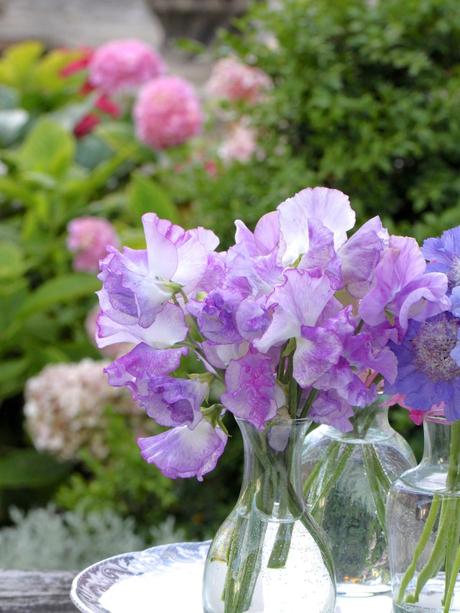
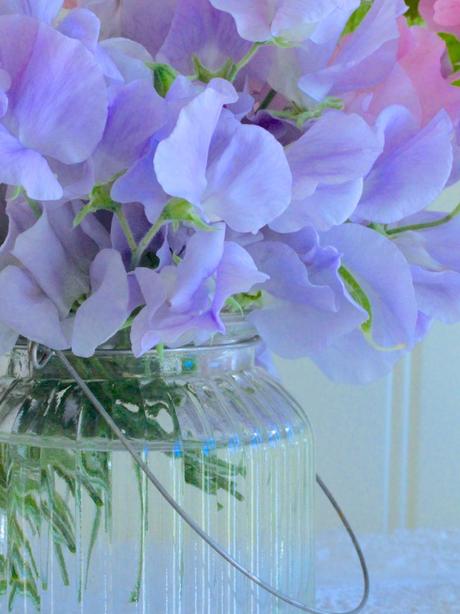
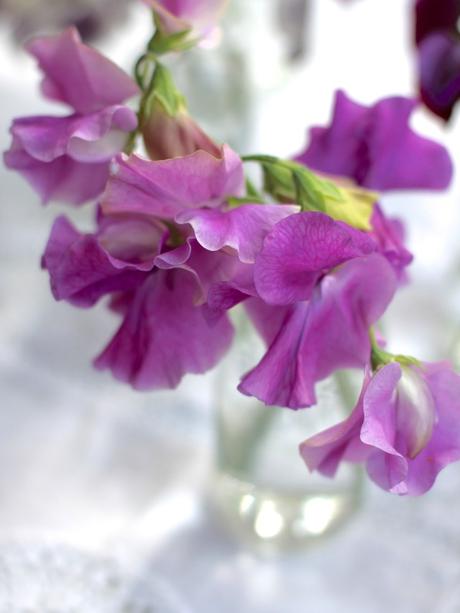
There are plenty of sweet pea seeds to buy in the garden centres now, or you can order online from Sarah Raven, Owl's Acre Sweet Peas and all the main seed suppliers. There is still plenty of time to order and sow your seeds, so if sweet peas are on your list this year do make sure you get on with growing them in February.
I am planning to revisit my sweet pea crop here once a month, so that you can see how they develop and I can explain more about my growing process. I also have my winter varieties growing in the greenhouse and they are really starting to take off now that the light is returning - next month I will show you how they are looking.
So will you be growing sweet peas this year? If you have any advice on varieties you like to grow or tips on getting the best from your sweet pea plants please do share it with us.

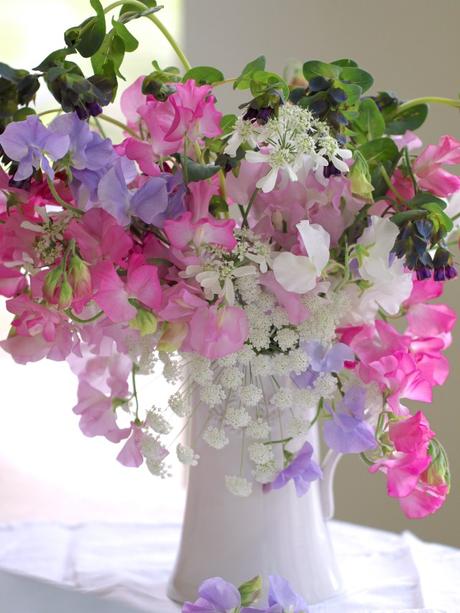
As we approach the beginning of February I like to finish sowing my sowing sweet peas for the summer. Sweet peas are the first of the annual flowers that I sow for my Cutting Garden every year. These beautiful frilly scented blooms are an early summer staple, producing plenty of cutting material from June to the end of July and often on into August and September if I have been rigorous about dead heading.

Sweet peas look beautiful on their supports, flower abundantly and have that unmistakable scent of summer when gathered together in a posy - a bunch of sweet peas on my kitchen windowsill is a summer must. My favourite colours are the delicate pastel pinks and lavenders, but I always grow a few dark varieties for contrast in the vase. Sadly 2015 was another poor year for my outdoor crop - for the second time my sweet peas were covered in tiny black pollen beetles making the flowers unusable inside. Apparently the beetles love the yellow flowers of the rapeseed crop and as these flowers fade they fly off in search of a new home - yet again my sweet pea crop proved very attractive to them. I did resolve last summer to concentrate my efforts on growing sweet peas under cover this year and forgo my outdoor crop, but gardening is often more about anticipation than results and I just cannot help but have another go outside this year. If nothing else these flowers add height and beauty to the Cutting Garden!

Although there is plenty of advice to the contrary I always soak my sweet pea seeds overnight before sowing - I find this speeds up germination considerably. I pour each variety of seed into a separate jam jar with the label underneath so that I do mot get the seeds mixed up. After soaking I drain each jar of seeds into a tea strainer and pour the plumped up seeds back into their packet.
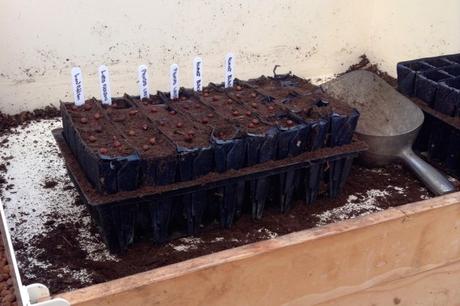
After soaking overnight the seeds almost double in size and sometimes start to sprout right there in the jar.
I then sow the seeds two to a plug into root trainers. Root trainers are ideal for sowing peas, beans and sweet peas, which all have long root growth.

After sowing, the seeds are well watered and then placed in my heated propagator to germinate. They would germinate just as well without heat, but the propagator speeds things up. I have never covered them to exclude light whilst they germinate, although many guides do recommend to do this. Within 4-5 days the seedlings will be showing and I will move them onto the greenhouse staging for a couple of weeks. After that it is into the cold frames to carry on growing and harden off before planting out, hopefully in late March or early April. In previous years I have pricked out the growing tip of the young plants just above a set of leaves to thicken them and create more bushy growth.
This year I am going to try the cordon method of growing - I will not prick out the growing tip and, as with tomatoes, I will remove all the side shoots as the plants grow to encourage one straight strong stem. This is the growing method which is meant to produce the largest flowers and longest stems which are in turn the best for cutting. I am aiming for quality over quantity this year!

Sweet peas love a rich moist soil in a bright sunny position and they are hungry plants (you cannot expect huge growth and mountains of flowers without generous feeding). Whilst they are in their pots the compost will feed them for the first 6 weeks or so of growth. As they will remain in their pots for a few more weeks until conditions are suitable for planting out, after about 5 weeks I will start to add liquid seaweed to the watering can once a week.
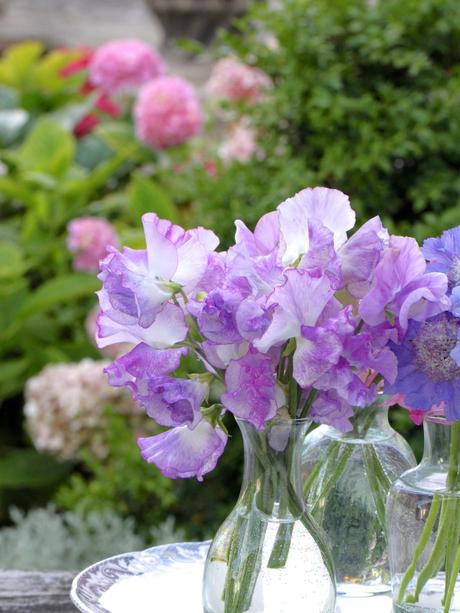
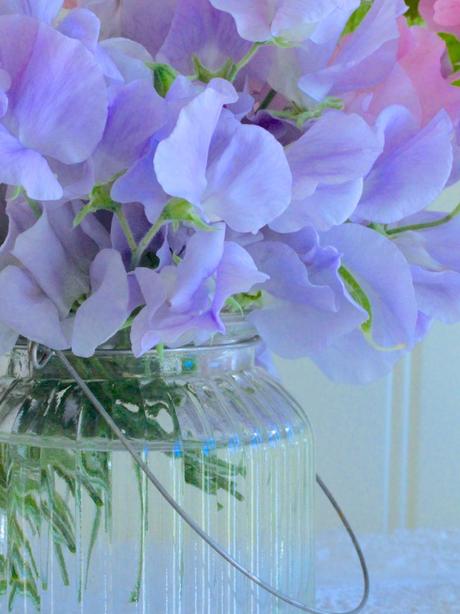
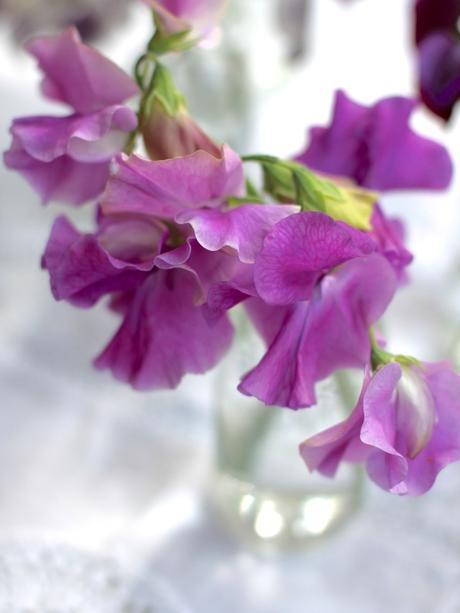
During February (weather permitting) I will prepare their planting space. I have adopted a metal runner bean frame which I cover with jute netting to support my sweet peas - this has proved very successful. I order the jute netting from Agriframes - it is much nicer to use than pea netting, which drives me to distraction as it knots itself around everything except my supports. At the end of the year the jute netting can be composted along with the old plants, which saves the frustrating task of trying to store unruly plastic pea netting in a tidy way.
This year I am going to prepare the soil by digging plenty of well rotted farmyard manure in a few weeks before planting the young plants 6 inches apart. After the plants have been transferred to their growing site I will continue with regular watering and a weekly feed of tomato food or liquid seaweed. A few weeks after planting I will start tying in the young plants to the jute netting to keep them in an upright position so that the stems climb up the supports rather than trail on the ground or become intertwined with each other. If a hard frost is forecast I will throw a fleece over the young plants just in case, but really they are quite hardy and cope well with the cool spring weather. Once they start to flower I will continue feeding and watering, making sure that all the flowers are cut off the plants at least once a week to stop them running to seed. With this regime they should be flowering from mid June until well into September, although the longest stems will only last for the first 6 weeks or so of flowering.
There are plenty of sweet pea seeds to buy in the garden centres now, or you can order online from Sarah Raven, Owl's Acre Sweet Peas and all the main seed suppliers. There is still plenty of time to order and sow your seeds, so if sweet peas are on your list this year do make sure you get on with growing them in February.
I am planning to revisit my sweet pea crop here once a month, so that you can see how they develop and I can explain more about my growing process. I also have my winter varieties growing in the greenhouse and they are really starting to take off now that the light is returning - next month I will show you how they are looking.
So will you be growing sweet peas this year? If you have any advice on varieties you like to grow or tips on getting the best from your sweet pea plants please do share it with us.

